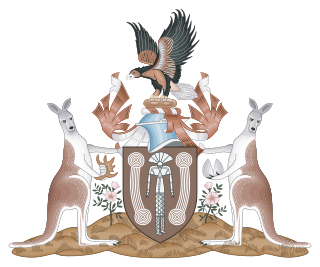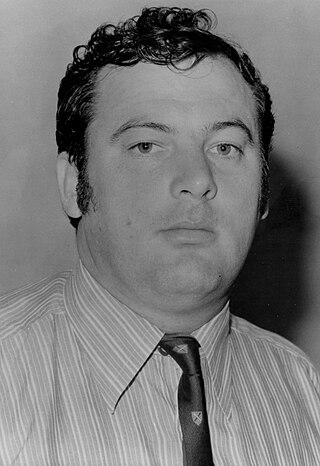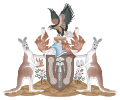
The Country Liberal Party of the Northern Territory (CLP), commonly known as the Country Liberals, is a centre-right and conservative political party in Australia's Northern Territory. In territory politics, it operates in a two-party system with the Australian Labor Party (ALP). It also contests federal elections as an affiliate of the Liberal Party of Australia and National Party of Australia, the two partners in the federal coalition.

The chief minister of the Northern Territory is the head of government of the Northern Territory. The office is the equivalent of a state premier. When the Northern Territory Legislative Assembly was created in 1974, the head of government was officially known as majority leader. This title was used in the first parliament (1974–1977) and the first eighteen months of the second. When the Northern Territory acquired limited self-government in 1978, the title of the head of government became chief minister with greatly expanded powers, though still somewhat less than those of a state premier.

Marshall Bruce Perron is a former Australian politician, who was a Country Liberal Party member of the Legislative Assembly in the Northern Territory from the formation of the Assembly in 1974 until his resignation in 1995. For the last 20 years, save for an 11-month break in 1986 and 1987, he served as a cabinet minister or its equivalent. From 1988 to 1995, Perron was the Chief Minister of the Northern Territory.

The Legislative Assembly of the Northern Territory is the unicameral legislature of the Northern Territory of Australia. The Legislative Assembly has 25 members, each elected in single-member electorates for four-year terms. The voting method for the Assembly is the full-preferential voting system, having previously been optional preferential voting. Elections are on the fourth Saturday in August of the fourth year after the previous election, but can be earlier in the event of a no confidence vote in the government. The most recent election for the Legislative Assembly was the 2024 election held on 24 August. The next election is scheduled for 26 August 2028.
The Leader of the Opposition is an official role usually occupied by the leader of the second largest party in the Northern Territory Legislative Assembly. In the event that that party or coalition wins an election, the Leader of the Opposition will most likely become the Chief Minister.

A general election was held in the Northern Territory, Australia, on 18 June 2005. The centre-left Labor Party, led by Chief Minister Clare Martin, won a second term with a landslide victory, winning six of the ten seats held by the opposition Country Liberal Party in the 25-member Northern Territory Legislative Assembly, bringing their total to 19. It was the second largest victory in any Northern Territory election. The only larger majority in the history of the Territory was in the first election, in 1974. In that contest, the CLP won 17 of the 19 seats in the chamber, and faced only two independents as opposition.

Paul Anthony Edward Everingham is a former Australian politician who was the head of government of the Northern Territory of Australia from 1977 to 1984, serving as the second and last Majority Leader (1977–1978) and the first Chief Minister of the Northern Territory from 1978 to 1984. He represented the northern Darwin seat of Jingili in the Northern Territory Legislative Assembly from 1974 to 1984. He was then elected to the federal House of Representatives, representing the Northern Territory between 1984 and 1987.

Michael Patrick Francis Gunner is an Australian former politician who was the 11th Chief Minister of the Northern Territory from 2016 to 2022. He was a Labor member of the Northern Territory Legislative Assembly, holding the seat of Fannie Bay in Darwin from the retirement of then Chief Minister Clare Martin at the 2008 election until his resignation in July 2022.

The chief minister of the Australian Capital Territory is the head of government of the Australian Capital Territory (ACT). The leader of the party with the largest number of seats in the unicameral Australian Capital Territory Legislative Assembly usually takes on the role. Unlike other states and territories, the chief minister is not appointed by a governor or administrator, but elected directly by the Assembly.

Roger Michael Steele is a former Australian politician. He was a Country Liberal Party member of the Northern Territory Legislative Assembly from 1974 to 1987, representing Ludmilla until 1983 and Elsey thereafter.

Lia Emele Finocchiaro is an Australian politician who has served as the Chief Minister of the Northern Territory since August 2024. A member of the Country Liberal Party (CLP), she has represented the seat of Spillett in the Northern Territory Legislative Assembly since her election in 2016. Following the resignation of Gary Higgins on 1 February 2020, she became the Leader of the Opposition in the Northern Territory. Prior to this, she served as the member for Drysdale from 2012 to 2016.
The Honourable or The Honorable is an honorific style that is used as a prefix before the names or titles of certain people, usually with official governmental or diplomatic positions.
The Burke Ministry was the ministry of the sixth Chief Minister of the Northern Territory, Denis Burke. It was sworn in on 9 February 1999, following the resignation of former Chief Minister Shane Stone the previous day. While Stone told the media that his resignation was "pretty much" of his own timing and he wished to give the new CLP leader sufficient time to prepare for the 2001 election, it followed a meeting of backbenchers and some cabinet ministers advocating his removal. Burke was elected unopposed as leader. It was in office until 26 August 2001, when the Burke government lost the 2001 election to Clare Martin's Labor Party.
The Perron Ministry was the ministry of the fourth Chief Minister of the Northern Territory, Marshall Perron. It was sworn in on 14 July 1988 after the resignation of Stephen Hatton as Chief Minister and his replacement by Perron.
The Hatton Ministry was the ministry of the third Chief Minister of the Northern Territory, Stephen Hatton. It was sworn in on 15 May 1986, following the ousting of former Chief Minister Ian Tuxworth by his Mines and Energy Minister, Hatton.
The Tuxworth Ministry was the ministry of the second Chief Minister of the Northern Territory, Ian Tuxworth. It was sworn in on 17 October 1984 after the resignation of Chief Minister Paul Everingham to run for the Australian House of Representatives and his replacement by Ian Tuxworth.
The Everingham Ministry was the ministry of Paul Everingham, the last Majority Leader of the Northern Territory before the granting of self-government, and the first Chief Minister of the Northern Territory. It first took office in 1977 following the defeat of former Majority Leader Goff Letts and much of his executive at the 1977 election, and became a full ministry with self-government in 1978. It lasted until 1984, when Everingham resigned to enter federal politics.
The Letts Executive was the executive of Majority Leader of the Northern Territory Goff Letts, who led the Northern Territory from the implementation of the Northern Territory Legislative Assembly in 1974 until his defeat in his own seat at the 1977 election. It was the first ministry to come from the Legislative Assembly. He was the only head of government of the Northern Territory not to assume the title of Chief Minister of the Northern Territory, as self-government was not granted until 1978. His governments did not have anywhere near the range of powers available to Territory governments after the granting of self-government, but nevertheless fulfilled similar functions. Letts' successor as Majority Leader and his one-time deputy, Paul Everingham, became the first Chief Minister in 1978.
The Stone Ministry was the ministry of the fifth Chief Minister of the Northern Territory, Shane Stone. It was sworn in on 26 May 1995, following the Country Liberal Party caucus' election of Stone as party leader following the resignation of Marshall Perron. It was in office until 8 February 1999, when Stone resigned, and was replaced by the ministry of incoming Chief Minister Denis Burke the next day.
Gerard Maley is an Australian politician who serves as an MLA for Nelson as a member of the Country Liberal Party in the Northern Territory Legislative Assembly. He has been the Deputy Leader of the Country Liberal Party since September 2020 and Deputy Chief Minister of the Northern Territory since 9 September 2024, following the 2024 Northern Territory general election.











